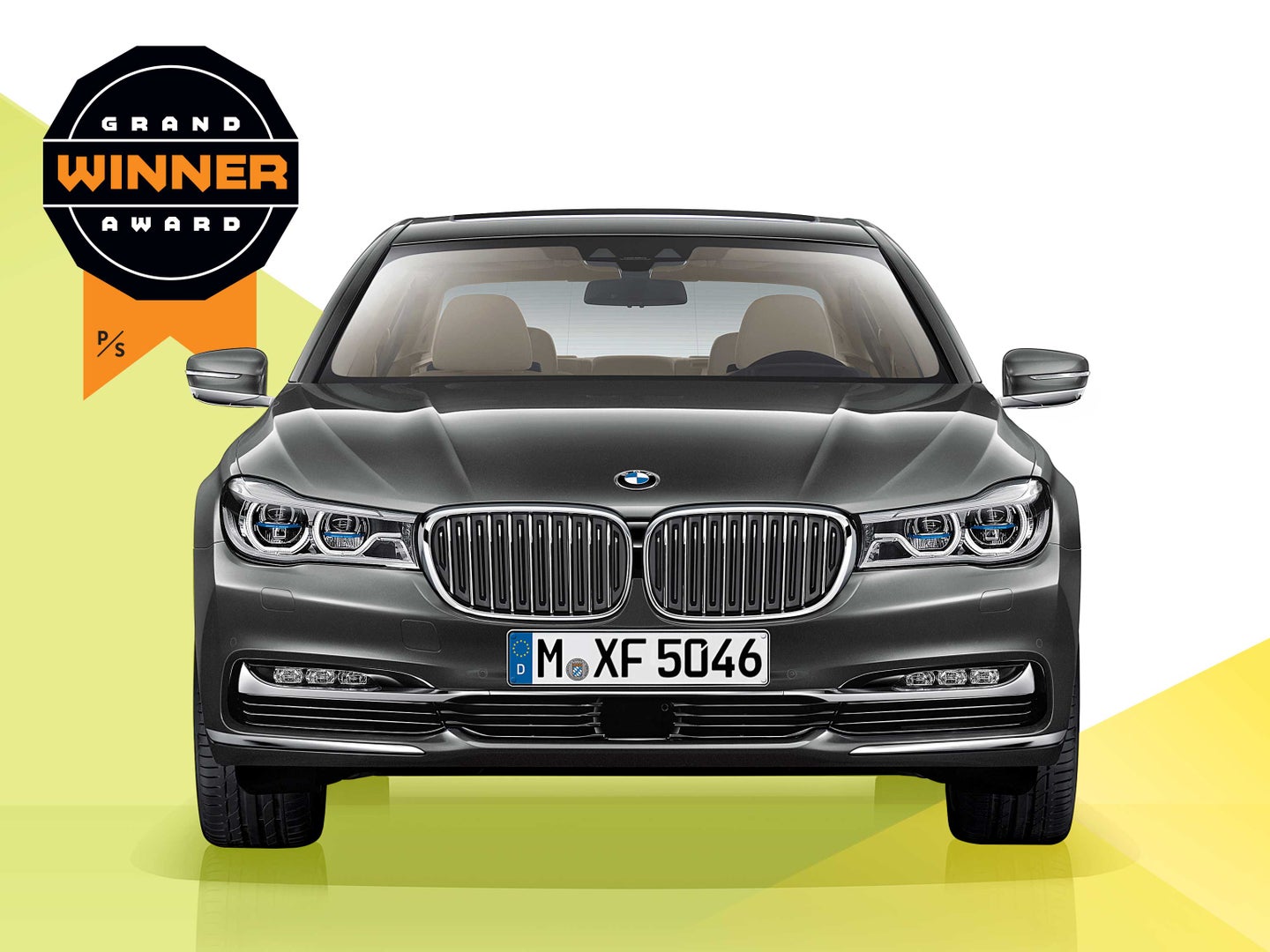Read about the other Best Of What’s New winners.
A New Wave In Driving
BMW 2016 7 Series: A New Wave In Driving
No longer will fumbling with a cellphone or reaching for a radio dial dangerously distract drivers. In October, BMW debuted the world’s first-ever gesture control in a car, allowing drivers to answer calls, use navigation, and adjust audio, all with conductorlike hand waves. That makes everyone safer. It also hints at the potential for hands-free driving. If that weren’t innovation enough, in U.S. models, BMW also took up to 190 pounds off the car’s weight, and improved fuel efficiency, by using carbon fiber in the chassis. That helps make the frame stiffer, which enhances performance. Luxury details also make the car feel like it belongs in a pricier class: Massage seats for rear passengers are helpful on long rides, LEDs in the moon roof mimic a starry sky, and programmable scents, like “woody,” emanate from the dash. $81,300
A Blast-Proof Truck
Oshkosh Light Combat Tactical All-Terrain Vehicle: A Blast-Proof Truck
In August, Oshkosh won a $6.7 billion defense contract to deliver the first new combat truck in 30 years. The Light Combat Tactical All-Terrain Vehicle has the ballistic protection of a light tank and the off-road agility of a Baja racer. It will replace the beloved (and hated) Humvee in coming years. The truck, which can carry more than the Humvee, uses bomb-resistant shaping and shielding similar to bigger and heavier tanks.
A Rear View That Sees It All
Cadillac CT6 Rear Camera Mirror: A Rear View That Sees It All
Among auto designers, rearview mirrors are rarely proving grounds for innovation. The new mirror in the CT6 stands apart. With the flick of a switch, drivers can convert it into an HD display. A camera captures a live stream from the car’s rear, which improves field of vision by 300 percent. The camera can enhance low-light scenes, manage brightness, and minimize glare. It’s a new way to see the road. Option $2,500
Safest Car On The Road
Volvo XC90: Safest Car On The Road
For a company that has built its name on safety, the Volvo XC90 is a signal achievement. The car acts like a co-pilot. With radar, cameras, and lane-drifting sensors, it will alert a distracted driver to pay attention, warn if you’re about to strike another vehicle, and take control to prevent a crash. And if the car leaves the road, the seat frames crumple downward and the seat belts tighten to reduce the risk of serious injury. $49,800
Fastest SUV Ever
Tesla Motors Model X: Fastest SUV Ever
The Model X challenges pretty much every assumption about SUVs. It’s fast: It races from 0 to 60 in 3.2 seconds and tops out at 155 mph. It’s safe: The bottom-mounted battery panel gives it the lowest center of gravity (meaning less chance of rollover) of any SUV made. And it’s slick: Falcon wing doors and a curved windshield make sure you’ll be the envy of any driver—especially other soccer dads. Price Not Set
A 190-MPH Hybrid
Acura 2017 NSX: A 190-MPH Hybrid
Hybrids are the new supercars—and Acura has just proved it. It has created a three-motor system for the NSX that maximizes handling, responsiveness, and fuel economy. It combines a midmounted twin-turbo V-6 engine with an electric motor—which delivers zero-delay acceleration—and with a motor at each front wheel. That provides precision power through a technique known as torque vectoring. So you have a car that jumps off the line and tackles turns like an IndyCar. $155,000
First Supercharged Street Motorcycle
Kawasaki Ninja H2: First Supercharged Street Motorcycle
With the Ninja H2, Kawasaki has created the first supercharged consumer motorcycle—one of the fastest bikes on the road. Superchargers usually appear only on niche racing bikes. They work by pressurizing the air/fuel mixture before it enters the engine, creating a powerful combustion. But they tend to be big and heavy. Kawasaki made a light, compact unit with 3-D-printed parts. The bike can reach 186 mph—not that you’d see it coming. $25,000
A 3D-Printed Supercar
Divergent Microfactories Blade: A 3-D-printed Supercar
Last May, Kevin Czinger created the Blade—the first high-performance supercar that uses 3-D-printed parts and a process that cuts typical auto-factory carbon emissions by up to 90 percent. By using carbon-fiber shafts and 3-D joints for the chassis, a car can be assembled in minutes. As founder of Divergent Microfactories, Czinger plans to open similar places for entrepreneurs to create their own car lines—for as little as $4 million.
Best Smartphone Interface
Android Auto: Best Smartphone Interface
Automakers continued to roll out systems to streamline the link between car and smartphone this year. Android Auto wins. It uses voice commands to make calls, select music, and get directions. And its Google Maps offers lane guidance for tricky interchanges, the latest traffic data, and directions to the nearest coffee shop.
Fastest Autonomous Car
Audi RS 7 Race Pilot: Fastest Autonomous Car
For autonomous cars, speed is critical. Just like their human counterparts, robot drivers will need to respond instantly at high speeds to changing road conditions. Armed with sensors, cameras, GPS, and machine-learning software, Audi’s RS 7 autonomous sedan set a 149-mph speed record for a robo-car in October 2014.










